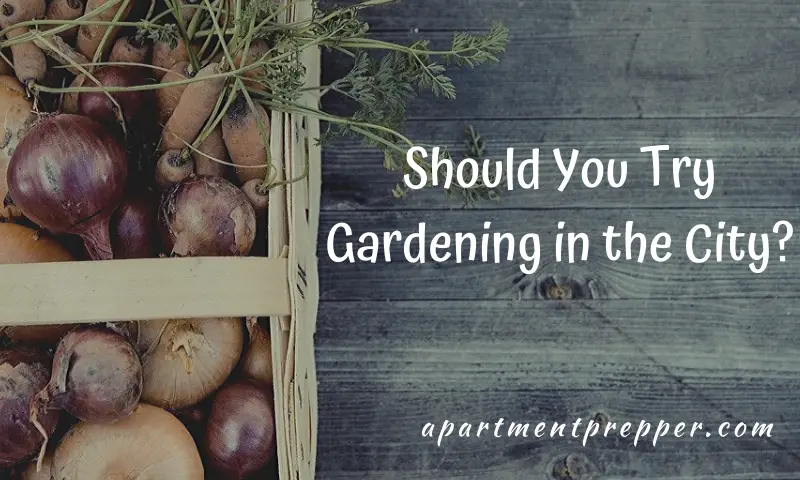Editor’s note: It’s springtime and we’re all having to shelter-in-place due to the coronavirus pandemic. Whether you live in a home in the suburbs, or in an apartment in the city, now is a great time to try your hand at gardening.
Should You Try Gardening in the City?
Guest Post by Garret Stembridge
Living in a city doesn’t mean you have to forgo your love of gardening. Regardless of whether you enjoy growing flowers for decoration or fruits and vegetables for consumption, virtually every home – no matter the size – has space available for gardening. Of course, living in a tiny apartment may require a little creativity, but there are many ways to convert urban living spaces into a gardener’s oasis.
Consider Your Location
Every urban area is different, so your gardening options may vary depending on the unique nature of your neighborhood. For example, if you live in a first level apartment or a detached single family home, you may have the luxury of creating a more conventional garden in a front, back, or side yard. However, renters should make sure they check with their landlord and review the terms of their lease before they start making substantial changes to the existing landscaping. For those in upper level apartments, patios, balconies, and fire escapes are the most likely places to capture sunlight. For either situation, window boxes are another possibility.
Contain Yourself
Novice gardeners may want to test the waters by growing plants in a few simple pots before investing a great amount of time and money in an urban garden project. Although you can easily find expensive containers to display your vegetation, buying inexpensive ones – or, better yet, borrowing used ones from friends or family members – is a smart economic strategy. In fact, you can even re-purpose old mason jars, plastic food containers, or other materials you have around the house without spending any money.
When focusing your efforts on traditional container gardening, remember that size matters. For example, plants that grow rapidly need plenty of room for their roots to expand. In contrast, planting tiny herbs in a large container may waste space you could have used for some other plant.
Going Vertical
Because most city dwellers will find themselves pressed for space, using any available vertical space will help maximize your gardening possibilities. For example, convert a discarded wooden pallet into a vertical plant container. First, secure any loose wooden boards and make sure no nails are exposed to prevent injury. Next, install landscape fabric or some other material to the rear of the pallet to provide space for soil and root growth, and to minimize damage to the wall on which the pallet will hang or lean against. Then, plant vegetation that will thrive in this sort of environment. Although plants with large, heavy leaves might not grow well in that sort of semi-horizontal position, trailing or cascading plants and herbs with more delicate leaves will likely do fine.
The same concept can work for converting a hanging pocket shoe organizer into a vertical plant container. For that project, the key is to ensure that the fabric material permits proper drainage and that the hooks used to secure the shoe-organizer-turned-garden-masterpiece are strong enough to handle the weight of the soil, plants, and water.
Others have had similar success using a wooden riddling rack, traditionally used to store or hold wine bottles. In the holes where the necks of wine bottles would usually rest, inserting soil and planting vegetation is a simple solution to an urban gardening dilemma.
Organize Your Neighbors
If you want even more space than a container garden or a vertical garden can provide, consult with your neighbors and talk about teaming up to find a space that you can use together. For example, some high-rise residents have convinced building owners to permit them to create a rooftop garden, with each participating resident paying a fee for a small plot of space. Others have used the common areas of their building, like a courtyard, to create a community garden. In other instances, people in an entire neighborhood band together and find vacant, unused space to transform into a neighborhood planting project. When going this route, make sure that you obtain approval from the appropriate individuals, such as the property owners or government officials, before you break ground.
Use Indoor Space Thoughtfully
Even if you have no available outdoor space, indoor plants are always an option. One example is planting assorted herbs in the aerogarden. Obviously, a wide variety of decorative indoor plants are available. In addition, however, many different citrus trees that provide edible fruit can grow indoors. Because these trees can be pricey, it’s best to do your research about how to properly care for them before making a purchase.
Using these tips, residents of urban areas can enjoy the amenities of a vibrant, bustling city, while still enjoying the freedom to create a garden and grow their own food. What are some of the things you’ve grown indoors? Do you have any tips you can share with new gardeners?
About the Author: Garret Stembridge is a member of the Extra Space Storage Internet marketing team. He contributes regularly at blog.extraspace.com.
(Full disclosure: We are an affiliate of Amazon.com, which means we received a small commission if you click through one of our Amazon links when you shop, at totally no cost to you. This helps keep the lights on at the blog. Thanks!)
)
Image by Markus Spiske from Pixabay




I live in a townhome with a 20×40 foot back yard. I have been container gardening for a few years and it has been successful. If you have a small patio you’ll be even more limited, but this is what I found works well. We actually produce more than my wife and I can consume. Herbs- planted in flower pots. Tomatoes, cucumbers, squash, green peppers- each in a bucket (Lowe’s or Home Depot types). Each bucket has holes for drainage and sits inside another, so it is not in contact with the pavement. The bottom bucket has a hole in the side to drain some water but keeps about an inch, to provide cooling. Towers- I took a large planter 2’ wide by 21/2 ‘ wide. I took a six feet of six inch pvc pipe and cut 2” holes along its length, except the last 2’. This I stood on end, with holes above the dirt in the planter. In one tree, I put strawberry plants in the sixteen holes cut along the length of the pipe and around the bottom in the planter. We get a few strawberries a day from Spring to Fall. In another, I planted leafy greens (lettuce varieties) in the holes and in the planter. I get mixed greens two to three nights a week. I’d post pics if there was a way, but you can find examples on Pinterest. Thing is… Try something. Try different plants. The things you learn may become important in the future.
Hi Carlos, That’s great your plants produce a lot! Thanks for the comment!
My family live in a small townhome with only a small balcony limited space in the front of our home due to hedges. Just before the end of last year I invested in a second AreoGarden system. I was impress with the smaller model that I purchased farm version. I learned to create my own pods and experiment with different seeds. I found salad grow quickly in days this was a plus and dwarf cherry tomatoes, Red Robbin, worked well. A container bin, 3ft x 2 1/2ft x 6”, seat in our balcony. I learned at least 6 inches depth is the minimum for some vegetable such as pepper and kale. Hanging basket for herbs. We have now expanded by removing a dead hedge that once occupied space with containers with okra and a small planter box. Creativity, researching and planning are keys.
Hi Carlos C, Thanks for sharing your experience with the AreoGarden. Appreciate the comment!